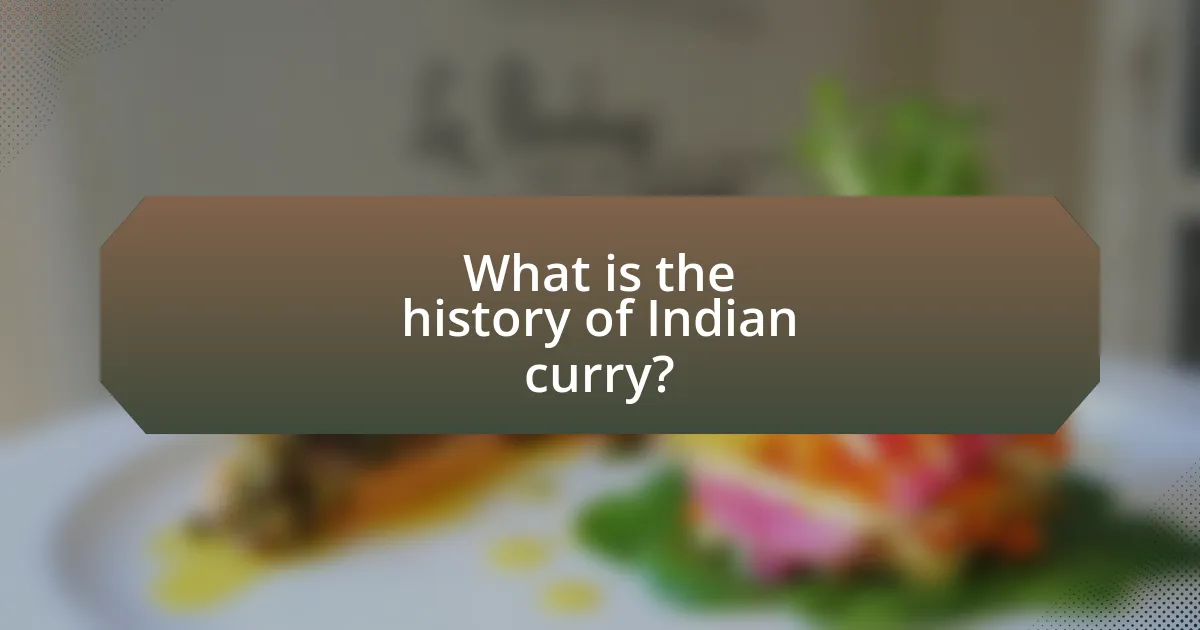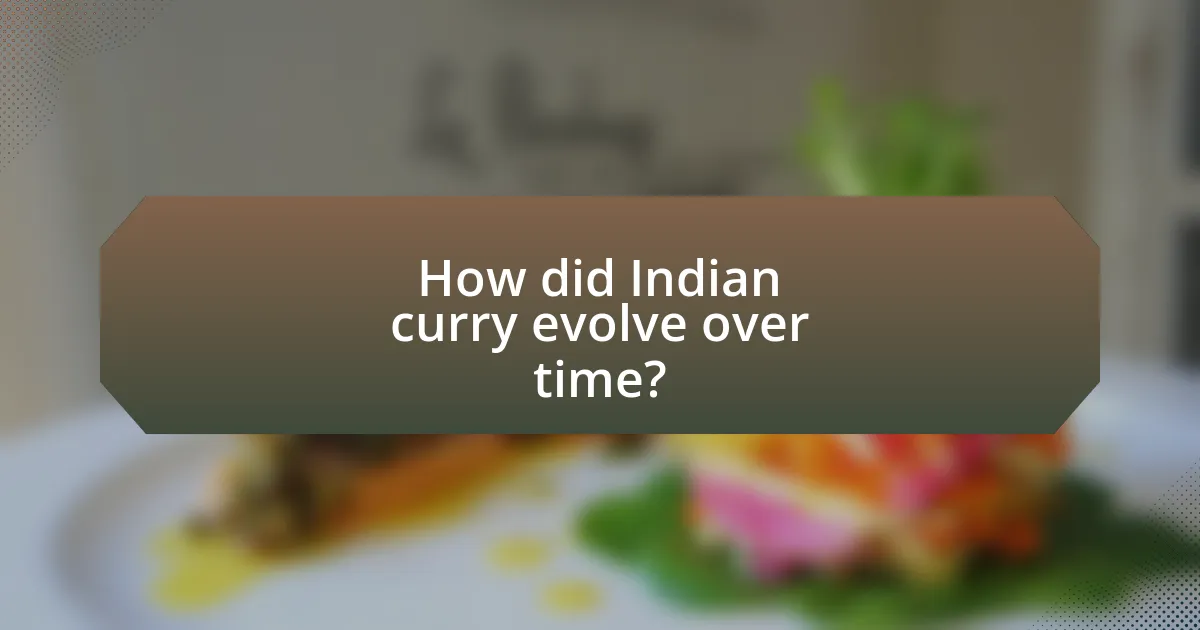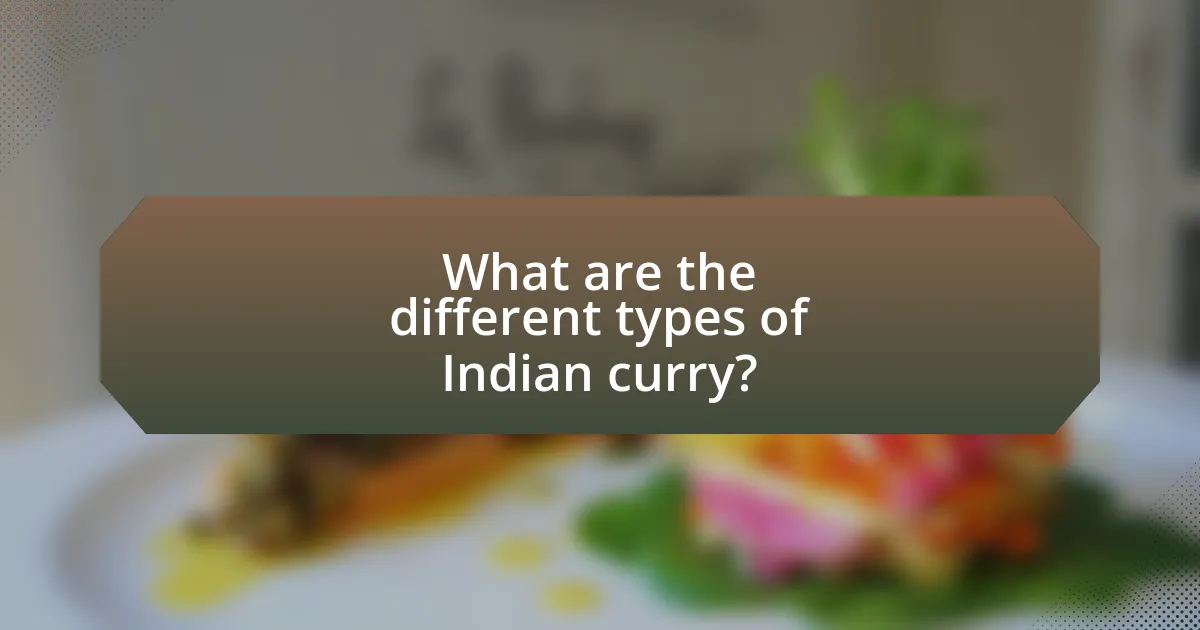The article explores the history and evolution of Indian curry, tracing its origins back to ancient Indian cooking practices that utilized a variety of spices and herbs. It highlights the influence of trade routes, the Mughal Empire, and British colonialism on the development and global popularity of curry. The article also examines the cultural significance of curry in Indian traditions, its integration into festivals and family rituals, and the diverse regional variations that characterize Indian cuisine. Additionally, it discusses the impact of the Indian diaspora on the international perception of curry and outlines different types and cooking methods associated with this iconic dish.

What is the history of Indian curry?
The history of Indian curry dates back thousands of years, with its roots in ancient Indian cooking practices that utilized a variety of spices and herbs. The term “curry” itself is derived from the Tamil word “kari,” which means sauce or relish for rice, indicating its origins in South Indian cuisine. Historical texts, such as the “Manasollasa” from the 12th century, document the use of spices in Indian cooking, showcasing the significance of flavor and health benefits.
As trade routes expanded, particularly during the Mughal Empire in the 16th century, the introduction of new spices and cooking techniques further evolved the concept of curry. The British colonial period in the 18th and 19th centuries popularized curry in Western cuisine, leading to the creation of dishes like “chicken curry” and “curry powder,” which were adapted from traditional Indian recipes. This transformation marked the beginning of curry’s global popularity, as it became a staple in various international cuisines, blending with local ingredients and flavors.
How did Indian curry originate?
Indian curry originated from the ancient practice of using spices in cooking, which dates back thousands of years in the Indian subcontinent. The use of spices such as turmeric, cumin, and coriander was documented in texts like the Rigveda, around 1500 BCE. Over time, regional variations emerged, influenced by local ingredients, cultural exchanges, and trade routes, particularly during the Mughal Empire, which introduced richer flavors and cooking techniques. This evolution led to the diverse array of curries seen in India today, reflecting a blend of indigenous and foreign culinary traditions.
What are the traditional ingredients used in early Indian curries?
Traditional ingredients used in early Indian curries include spices such as turmeric, cumin, coriander, and mustard seeds, along with vegetables like onions, garlic, and ginger. These ingredients formed the foundation of flavor and aroma in Indian cuisine, with turmeric providing color and health benefits, while cumin and coriander contributed to the distinctive taste. Historical texts and culinary records indicate that these spices were integral to the development of curry as a dish, reflecting the agricultural practices and trade routes of ancient India.
How did regional variations influence the development of Indian curry?
Regional variations significantly influenced the development of Indian curry by incorporating local ingredients, cooking techniques, and cultural practices. For instance, in the northern regions, the use of dairy products like yogurt and cream is prevalent, leading to richer, creamier curries such as butter chicken. In contrast, southern Indian curries often feature coconut and tamarind, resulting in lighter, tangier dishes like sambar. Additionally, the diverse climate and agricultural practices across India have led to the availability of different spices and vegetables, further diversifying curry recipes. Historical trade routes also introduced new spices, such as black pepper and cardamom, which became integral to regional flavors. Thus, the interplay of geography, climate, and cultural exchange has shaped the unique characteristics of Indian curry across various regions.
What cultural significance does Indian curry hold?
Indian curry holds significant cultural importance as it embodies the rich culinary heritage and diversity of India. This dish reflects regional variations, with each state contributing unique spices and cooking techniques, showcasing India’s agricultural bounty and cultural practices. Historically, curry has been a staple in Indian households for centuries, symbolizing hospitality and communal dining. The use of spices in curry not only enhances flavor but also represents traditional medicinal practices, as many spices are known for their health benefits. Furthermore, Indian curry has transcended borders, influencing global cuisine and fostering cultural exchange, making it a symbol of India’s global culinary identity.
How is curry integrated into Indian festivals and rituals?
Curry is integral to Indian festivals and rituals, serving as a symbol of hospitality and celebration. During major festivals like Diwali and Holi, various curry dishes are prepared to honor deities and share with family and friends, reflecting the cultural significance of food in communal gatherings. For instance, during Diwali, dishes such as paneer butter masala and chole are commonly made, showcasing regional variations and traditional recipes passed down through generations. Additionally, in rituals like weddings, elaborate curry preparations are essential, representing abundance and prosperity. The inclusion of curry in these events underscores its role in fostering community bonds and preserving culinary heritage.
What role does curry play in Indian family traditions?
Curry plays a central role in Indian family traditions by serving as a symbol of hospitality and cultural identity. In Indian households, curry is often the centerpiece of meals, reflecting regional diversity and family heritage. The preparation and sharing of curry dishes during family gatherings and celebrations reinforce bonds among family members, as recipes are often passed down through generations, preserving cultural practices. Additionally, the use of various spices in curry not only enhances flavor but also signifies the importance of health and wellness in Indian cuisine, aligning with traditional beliefs about food’s role in nurturing both body and spirit.

How did Indian curry evolve over time?
Indian curry evolved over time through a combination of regional influences, trade, and cultural exchanges. Initially, ancient Indian cooking utilized local spices and herbs, with the earliest references to curry-like dishes found in texts dating back to 2000 BCE. The introduction of new ingredients, such as chili peppers from the Americas in the 16th century, significantly transformed the flavor profiles of curries. Additionally, the Mughal Empire’s influence in the 16th and 17th centuries brought Persian cooking techniques and ingredients, further diversifying curry styles. The British colonial period in the 19th century popularized Indian curry in the West, leading to adaptations that catered to Western tastes. Today, Indian curry encompasses a wide variety of regional styles and has gained global popularity, reflecting its rich historical evolution.
What were the key influences on the evolution of Indian curry?
The key influences on the evolution of Indian curry include regional diversity, historical trade routes, and colonial interactions. Regional diversity in India led to the incorporation of local ingredients and cooking techniques, resulting in a wide variety of curry styles across different states. Historical trade routes, such as the Silk Road and maritime trade, facilitated the exchange of spices and culinary practices, enriching Indian cuisine. Additionally, colonial interactions, particularly during British rule, introduced new ingredients and methods, further shaping the development of curry. For example, the British adaptation of Indian dishes led to the creation of Anglo-Indian curry recipes, which blended traditional Indian flavors with British tastes.
How did colonialism impact the ingredients and preparation of curry?
Colonialism significantly altered the ingredients and preparation of curry by introducing new spices and cooking techniques from Europe and other colonized regions. The British colonial presence in India led to the incorporation of ingredients such as potatoes, tomatoes, and chili peppers, which were not traditionally used in Indian cuisine. These ingredients transformed the flavor profile and texture of curry dishes. Additionally, the British adaptation of curry for their palate resulted in the simplification of preparation methods, often reducing the complexity of traditional recipes. Historical records indicate that the British popularized curry in their own cuisine, leading to the creation of dishes like “chicken tikka masala,” which reflects a fusion of Indian and British culinary practices.
What role did trade routes play in the spread of curry spices?
Trade routes were crucial in the spread of curry spices by facilitating the exchange of goods and cultural practices across regions. Historically, routes such as the Silk Road and maritime paths connected India with the Middle East, Southeast Asia, and Europe, allowing spices like turmeric, cumin, and coriander to reach new markets. The demand for these spices in various cuisines led to their integration into local dishes, thereby popularizing curry beyond its Indian origins. For instance, the spice trade flourished during the Mughal Empire, which significantly influenced culinary practices in neighboring regions, further embedding curry spices into global gastronomy.
How did Indian curry gain global popularity?
Indian curry gained global popularity primarily through the British colonial influence in India during the 18th and 19th centuries, which introduced Indian cuisine to Western palates. The British returned home with recipes and spices, leading to the establishment of Indian restaurants in the UK. By the mid-20th century, the dish became a staple in British cuisine, exemplified by the popularity of chicken tikka masala, which was declared a national dish in 2001. Additionally, the globalization of food culture, facilitated by migration and the rise of the internet, further spread Indian curry worldwide, making it accessible and appealing to diverse audiences.
What factors contributed to the internationalization of Indian curry?
The internationalization of Indian curry was primarily driven by globalization, migration patterns, and the rise of the Indian diaspora. Globalization facilitated the spread of culinary traditions across borders, allowing Indian curry to reach diverse markets. Migration patterns, particularly during the British colonial period and post-independence, led to significant Indian communities establishing themselves in various countries, where they introduced their cuisine. The Indian diaspora, now numbering over 30 million globally, has played a crucial role in popularizing Indian curry through restaurants, food festivals, and cultural exchanges, making it a staple in many international cuisines.
How did Indian diaspora communities influence the global perception of curry?
Indian diaspora communities significantly influenced the global perception of curry by introducing diverse regional variations and adapting traditional recipes to local tastes. As Indian immigrants settled in various countries, they established restaurants and food businesses that showcased curry dishes, making them accessible to a broader audience. For instance, the proliferation of Indian restaurants in the UK during the 20th century led to the popularization of dishes like chicken tikka masala, which has been dubbed a national dish. This adaptation not only highlighted the versatility of curry but also contributed to its acceptance and integration into various culinary traditions worldwide. The diaspora’s efforts in promoting Indian cuisine through cultural festivals and cooking classes further enhanced the global appreciation of curry, transforming it from a traditional Indian dish into a beloved global staple.

What are the different types of Indian curry?
Indian curry encompasses a variety of types, including but not limited to, Butter Chicken, Rogan Josh, Tikka Masala, Korma, and Vindaloo. Each type is characterized by its unique blend of spices, cooking techniques, and regional influences. For instance, Butter Chicken is known for its creamy tomato sauce and is a staple of North Indian cuisine, while Vindaloo, originating from Goa, is recognized for its spicy and tangy flavor profile, often featuring vinegar and garlic. The diversity in Indian curry reflects the country’s rich culinary heritage, with each region contributing distinct ingredients and preparation methods, making Indian curry a globally celebrated dish.
What are the main categories of Indian curry?
The main categories of Indian curry include vegetarian, non-vegetarian, and regional variations. Vegetarian curries often feature ingredients like lentils, vegetables, and paneer, while non-vegetarian curries typically include chicken, lamb, or fish, prepared with various spices and sauces. Regional variations, such as North Indian curries like butter chicken and South Indian curries like sambar, showcase the diversity of flavors and cooking techniques across India. This classification reflects the rich culinary heritage and adaptability of Indian cuisine, making it popular worldwide.
How do vegetarian and non-vegetarian curries differ in preparation?
Vegetarian and non-vegetarian curries differ primarily in the ingredients and cooking techniques used. Vegetarian curries typically rely on a variety of vegetables, legumes, and dairy products, while non-vegetarian curries incorporate meat, poultry, or seafood as the main protein source.
In vegetarian curries, the preparation often involves sautéing spices and aromatics, followed by the addition of vegetables or legumes, which are simmered until tender. Common ingredients include lentils, chickpeas, and a range of seasonal vegetables, often enhanced with coconut milk or yogurt for creaminess.
In contrast, non-vegetarian curries require marinating the meat or seafood in spices and sometimes yogurt before cooking. The meat is usually browned first to develop flavor, and then simmered with spices and other ingredients until fully cooked. This method allows the meat to absorb the spices, resulting in a rich and flavorful dish.
The distinct preparation methods reflect the different cooking times and techniques required for vegetables versus proteins, ensuring that each type of curry achieves its intended flavor and texture.
What are some popular regional curries in India?
Some popular regional curries in India include Butter Chicken from North India, Rogan Josh from Kashmir, and Fish Curry from West Bengal. Butter Chicken, originating in Delhi, features marinated chicken cooked in a creamy tomato sauce, reflecting the Mughlai culinary influence. Rogan Josh, a staple in Kashmiri cuisine, consists of tender lamb cooked with aromatic spices, showcasing the region’s rich heritage. Fish Curry from West Bengal is characterized by its use of mustard oil and spices, highlighting the coastal flavors of the eastern region. These curries exemplify the diverse culinary landscape of India, each representing unique regional ingredients and cooking techniques.
What are the common cooking methods for Indian curry?
Common cooking methods for Indian curry include sautéing, simmering, and pressure cooking. Sautéing involves frying spices and aromatics in oil to build flavor, while simmering allows the curry to cook slowly, melding the ingredients together. Pressure cooking is often used for quicker preparation, especially with tougher meats or legumes, ensuring they become tender while retaining moisture. These methods are foundational in Indian cuisine, contributing to the rich and diverse flavors characteristic of Indian curries.
How does the use of spices vary across different cooking methods?
The use of spices varies significantly across different cooking methods, impacting flavor, aroma, and health benefits. In dry heat methods like roasting or grilling, spices are often used as rubs or marinades, allowing their essential oils to concentrate and enhance the dish’s flavor. Conversely, in moist heat methods such as boiling or steaming, spices are typically added to the cooking liquid, which can dilute their potency but allows for a more subtle infusion of flavors. Additionally, in methods like sautéing or frying, spices are often tempered in oil, which helps to release their flavors more effectively due to the fat’s ability to extract and carry aromatic compounds. This variation in application is supported by culinary practices across cultures, where techniques like tempering in Indian cuisine highlight the importance of cooking methods in maximizing spice efficacy.
What techniques are essential for achieving authentic flavors in curry?
Essential techniques for achieving authentic flavors in curry include the use of fresh spices, proper tempering, and slow cooking. Fresh spices, such as cumin, coriander, and turmeric, release their essential oils and flavors when ground just before use, enhancing the dish’s overall taste. Proper tempering involves heating oil and adding whole spices like mustard seeds or curry leaves, which infuse the oil with flavor and aroma, creating a robust base for the curry. Slow cooking allows the spices to meld and develop deeper flavors, often resulting in a more complex and satisfying dish. These techniques are rooted in traditional Indian cooking practices, which emphasize the importance of ingredient quality and cooking methods in achieving authentic taste.
What are some tips for making Indian curry at home?
To make Indian curry at home, start by using fresh spices and ingredients for authentic flavor. Freshly ground spices, such as cumin, coriander, and turmeric, enhance the taste significantly compared to pre-ground options. Additionally, sautéing onions until golden brown creates a rich base, while incorporating garlic and ginger adds depth. Cooking the spices in oil before adding other ingredients helps release their essential oils, intensifying the flavor. Finally, allowing the curry to simmer for a longer period allows the flavors to meld together, resulting in a more robust dish.
